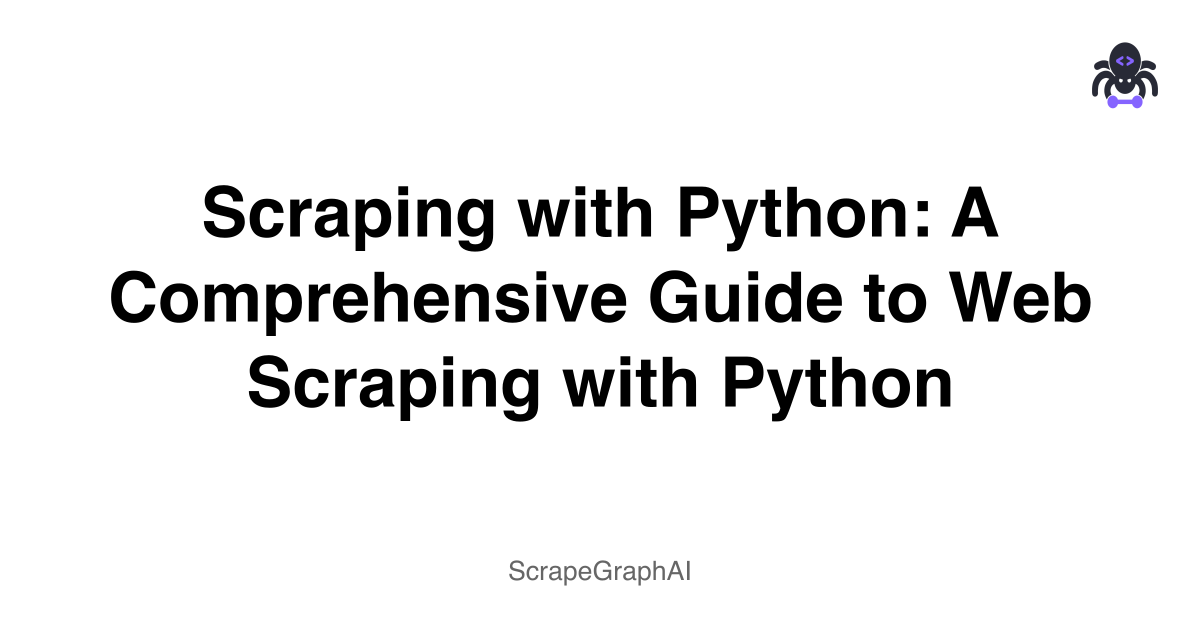Python has become the go-to language for web scraping due to its simplicity and powerful libraries. Let's explore how to effectively scrape modern websites using Python's best tools and practices.
1. Understanding the Challenge
- Dynamic Content: Modern websites use JavaScript frameworks like React, Vue, and Angular
- API-Driven Data: Content often loads asynchronously through API calls
- Common Obstacles: Infinite scroll, lazy loading, and anti-bot measures
2. Python's Scraping Arsenal
BeautifulSoup4
The classic HTML/XML parser. Perfect for static content and simple scraping tasks.
Selenium
Browser automation powerhouse. Great for JavaScript-heavy sites.
Scrapy
Full-featured scraping framework. Excellent for large-scale projects.
Requests + aiohttp
HTTP clients for making API calls and handling asynchronous requests.
3. Quickstart with BeautifulSoup4
Installation
First, let's set up our environment. You'll need Python and pip installed:
pip install beautifulsoup4 requestsBasic Extraction
Here's a simple example using BeautifulSoup4 to extract all headings from a webpage:
import requests
from bs4 import BeautifulSoup
def scrape_headings(url):
# Send HTTP request
response = requests.get(url)
response.raise_for_status()
# Parse HTML
soup = BeautifulSoup(response.text, 'html.parser')
# Extract all headings
headings = soup.find_all(['h1', 'h2'])
return [heading.text.strip() for heading in headings]
# Usage
url = 'https://example.com"
headings = scrape_headings(url)
print(headings)Handle Dynamic Content
For JavaScript-rendered content, we'll need Selenium. Here's how to set it up:
pip install selenium webdriver-managerfrom selenium import webdriver
from selenium.webdriver.chrome.service import Service
from selenium.webdriver.chrome.options import Options
from webdriver_manager.chrome import ChromeDriverManager
from selenium.webdriver.common.by import By
from selenium.webdriver.support.ui import WebDriverWait
from selenium.webdriver.support import expected_conditions as EC
def scrape_dynamic_content(url):
# Setup Chrome options
chrome_options = Options()
chrome_options.add_argument('--headless')
# Initialize the driver
driver = webdriver.Chrome(
service=Service(ChromeDriverManager().install()),
options=chrome_options
)
try:
# Load the page
driver.get(url)
# Wait for content to load
WebDriverWait(driver, 10).until(
EC.presence_of_element_located((By.TAG_NAME, "h1"))
)
# Extract content
headings = driver.find_elements(By.CSS_SELECTOR, 'h1, h2')
return [heading.text for heading in headings]
finally:
driver.quit()
# Usage
url = 'https://example.com"
headings = scrape_dynamic_content(url)
print(headings)Handle Infinite Scroll
Here's how to handle infinite scroll with Selenium:
def handle_infinite_scroll(driver):
last_height = driver.execute_script("return document.body.scrollHeight")
while True:
# Scroll down
driver.execute_script("window.scrollTo(0, document.body.scrollHeight);")
# Wait for new content
time.sleep(2)
# Calculate new scroll height
new_height = driver.execute_script("return document.body.scrollHeight")
# Break if no more content
if new_height == last_height:
break
last_height = new_heightBypass Anti-bot Measures
Here's how to make your scraper more human-like:
def setup_stealth_driver():
chrome_options = Options()
chrome_options.add_argument('--headless')
chrome_options.add_argument('--disable-blink-features=AutomationControlled')
chrome_options.add_experimental_option("excludeSwitches", ["enable-automation"])
chrome_options.add_experimental_option('useAutomationExtension', False)
driver = webdriver.Chrome(
service=Service(ChromeDriverManager().install()),
options=chrome_options
)
# Modify navigator.webdriver
driver.execute_script("Object.defineProperty(navigator, 'webdriver', {get: () => undefined})")
return driver4. Advanced Scraping with Scrapy
Installation
Scrapy is a powerful framework for large-scale scraping:
pip install scrapyBasic Spider
Here's a simple Scrapy spider:
import scrapy
class ExampleSpider(scrapy.Spider):
name = 'example"
start_urls = ['https://example.com']
def parse(self, response):
# Extract headings
for heading in response.css('h1, h2'):
yield {
'text': heading.css('::text').get(),
'type': heading.css('::attr(tag)').get()
}
# Follow links
for href in response.css('a::attr(href)'):
yield response.follow(href, self.parse)Running the Spider
scrapy runspider spider.py -o output.json5. Best Practices
- Rate Limiting: Use delays between requests
- User Agents: Rotate user agents
- Error Handling: Implement robust error handling
- Proxy Rotation: Use proxy services for large-scale scraping
- Data Storage: Save data incrementally
6. Legal & Ethical Considerations
- Always check robots.txt
- Respect website terms of service
- Implement reasonable request rates
- Store data responsibly
7. Commercial Solutions
- ScrapeGraphAI API-based service with the use of the AI for scraping the web.
- ScrapingBee: API-based scraping service
- ScraperAPI: Proxy rotation and browser automation
- Bright Data: Enterprise-grade scraping infrastructure
Conclusion
Python offers a rich ecosystem for web scraping. Whether you're building a simple scraper with BeautifulSoup4 or a large-scale system with Scrapy, Python has the tools you need. Remember to scrape responsibly and respect website policies.
Ready to simplify your Python web scraping? ScrapeGraphAI empowers you to scrape any website in as little as 5 lines of code, eliminating the usual complexities and headaches. Experience the future of data extraction. Give ScrapeGraphAI a try!
Quick FAQs
BeautifulSoup4 or Selenium?
Use BeautifulSoup4 for static content, Selenium for JavaScript-heavy sites.
How to handle CAPTCHAs?
Consider using commercial services or implementing CAPTCHA solving services.
Best way to store scraped data?
Use databases like PostgreSQL or MongoDB for structured data.
How to scale scraping?
Use Scrapy with distributed crawling or cloud-based solutions.
Is it legal?
Generally yes, if you follow website terms and robots.txt. Always check first.
How to find hidden APIs?
Use browser DevTools > Network tab to monitor XHR/fetch requests.
Related Resources
Want to learn more about Python web scraping? Explore these guides:
- Web Scraping 101 - Master the basics of web scraping
- AI Agent Web Scraping - Learn about AI-powered scraping
- Mastering ScrapeGraphAI - Deep dive into our scraping platform
- Building Intelligent Agents - Create powerful automation agents
- Pre-AI to Post-AI Scraping - See how AI has transformed automation
- Structured Output - Learn about data formatting
- Data Innovation - Discover innovative data methods
- Full Stack Development - Build complete data solutions
- Web Scraping Legality - Understand legal considerations
These resources will help you master Python web scraping while building powerful solutions.
